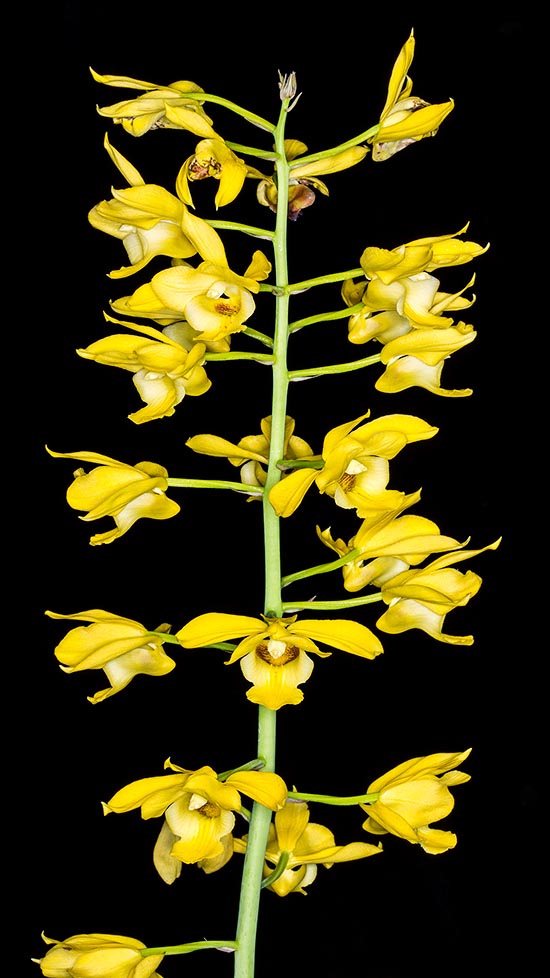Family : Orchidaceae

Text © Pietro Puccio

English translation by Mario Beltramini

Eulophia flava is a deciduous terrestrial species of South-East Asia © Giuseppe Mazza
The name of the genus is the combination of the Greek prefix “εὖ” (eu) = well, good, pleasant, and of the substantive “λόφος” (lophos) = crest, with reference to the crests present on the labellum; the specific name is the Latin adjective “flavus, a, um” = yellow, with obvious reference.
Common names: yellow eulophia (English); huang hua mei guan lan (Chinese); luân lan vàng (Vietnamese).
The Eulophia flava (Lindl.) Hook.f. (1890) is a deciduous terrestrial species with obconical pseudobulbs, 4-6 cm long and of 4-8 cm of diameter, connected one after the other, usually provided of 2 lanceolate leaves with pointed apex, 25-60 cm long and 3-8 cm broad.
Lateral racemose inflorescences produced before the emission of the leaves, 0,6-1,5 m long, with 10-30 yellow flowers with brown-reddish spots at the base of the labellum, sllightly scented. Oblong-lanceolate dorsal sepal with pointed apex, 3-3,5 cm long and 1,4 cm broad, lateral sepals 3,6-4 cm long and 1,6 cm broad, obovate-elliptic petals with obtuse apex, 2,5-3 cm long and 1,5-1,8 cm broad, trilobed labellum, 2,8-3,2 cm long and 2,5-3,5 cm broad, run by three crests, with lateral lobes rounded and curved at the sides of the column and median orbicular lobe, column 1,5-2 cm long.
It reproduces by seed, in vitro, and easily by division during the resting period.
Species of great ornamental value thanks to the high inflorescences with bright yellow flowers lasting individually 10-12 days, requires high luminosity, abundant water and high temperatures, 25-38 °C, during the vegetative period, cooler, with lowest values not under the 15 °C, and maintained dry during the resting period, till the emission of the inflorescence, therefore cultivable in open ground in the seasonal climate regions.
Elsewhere, it can be cultivated in pot, preferably of earthenware, in sandy loam rich of organic substance, acidic or neutral, with the aforementioned water regime and temperature; fundamental for the blooming is the observance of the period of dry rest, in absence of which it produces only leaves.
The species is reported in the appendix II of CITES (species whose trade is internationally ruled).

Obconical pseudobulbs, 4-6 cm long and of 4-8 cm of diameter, connected one after the other, usually provided of two lanceolate leaves with pointed apex, of 25-60 cm. The racemose inflorescences, produced before the leaves emission, measure 0,6-1,5 m with 10-30 flowers that may reach, with lateral sepals, the 8 cm © G. Mazza
→ For general notions about ORCHIDACEAE please click here.
